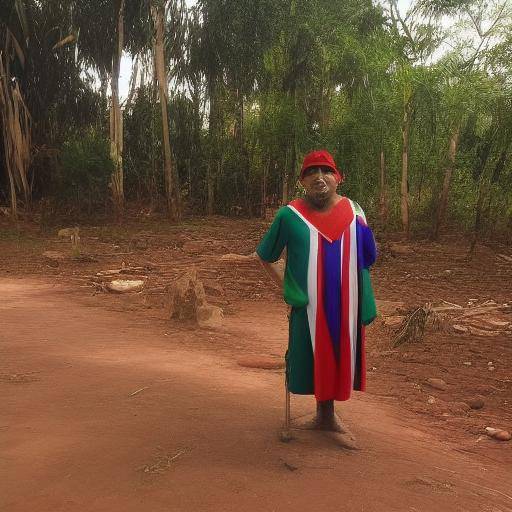
Kurupí is one of the most enigmatic and seductive mythological characters in Paraguay. His figure, close to that of a leprechaun, is wrapped in an aura of mystery and sensuality. Through this article, we will discover the history, cultural meaning and connection to the fertility related to Kurupí in Paraguay. In addition, we will explore the beliefs and legends that revolve around this enigmatic being, as well as its impact on the culture and worldview of the Guaraní people.
Introduction
The Legend of Kurupi
In the Guaraní mythology, Kurupí is known as a naughty and libidinose being living in the forests of Paraguay. It is described as a man of low stature, hunched, with feet turned back and a long melena covering his face. It is often represented with a pipe and a cane or a rod. Despite its unusual appearance, Kurupí is famous for its irresistible charm and its ability to seduce women and young people. Being an icon of fertility, it is believed that those who wish to conceive seek their favor.
Cultural and Social Relevance
The myth of Kurupi is much more than just a legend. In Paraguayan culture, its presence is palpable, influencing popular beliefs, everyday life and traditions. This connection with fertility also gives it a prominent place in rituals and ceremonies related to conception and pregnancy. In addition, the artistic and literary representations of Kurupí abound, which demonstrates its roots in the collective imagination of the Guaraní people.
In this sense, Kurupí is not only a folklore character; it is a symbol that reflects the complex interaction between the ancestral mythology and the contemporary identity of Paraguay.
History and Origins
The legend of Kurupi dates back to time immemorial, rooted in the worldview of the Guaraní people. Despite its ancient origins, this figure still persists in Paraguayan society, transmitting from generation to generation through oral accounts, dances and festivals.
Evolution of the Myth
The Kurupí story has evolved over time, adapting to social and cultural changes. This adaptability has allowed it to maintain its relevance in contemporary society, becoming a symbol not only of fertility, but also of rebellion and desire.
Significado Cultural
Kurupí, in addition to its association with fertility, embodies universal human values and dilemmas, which has contributed to its lasting collective consciousness. His figure awakens reflections on desire, attraction and moral limits, thus providing a lens through which the complexity of human nature can be analyzed.
Contemporary Relevance
Despite living in a modern and globalized world, the Kurupí myth remains an integral part of Paraguay's cultural identity. Its presence is manifested in various artistic and popular expressions, reaffirming its importance in today's society.
Analysis in Deep
Rol in Fertility
Kurupí is not only a symbol of fertility; it is a central element in rituals and beliefs related to conception and pregnancy. Couples who wish to have children often resort to practices that seek the protection and blessing of Kurupi, which demonstrates their influence on everyday life in Paraguay.
Impact on Traditions
The myth of Kurupí is intertwined with Paraguayan traditions and customs, influencing festivities and ceremonies associated with fertility. His presence is manifested in dances, songs and theatrical performances that seek to honor his role in Guaraní culture. In addition, it has adapted to new forms of artistic expression, finding its place in literature, cinema and contemporary art.
Contemporary Interpretations
In the current context, the Kurupi myth has been the subject of critical interpretations and creative reinventions. Its meaning has been explored from feminist, anthropological and psychological perspectives, generating an enriching dialogue on the influence of Kurupí in modern society.
Comprehensive review
Comparison with Other Mystic Figures
Kurupí shares similarities and contrasts with other mythical figures present in different cultures. To compare its characteristics and roles reveals universal aspects and unique peculiarities of Guaraní mythology, enriching our understanding of the beliefs and traditions of Paraguay.
Modern applications
The myth of Kurupí has transcended its folkloric origin to influence various spheres of contemporary life, from art and literature to psychology and sociology. Exploring its modern applications allows us to appreciate its impact on the current society and project its relevance to the future.
Multidisciplinary perspectives
The study of Kurupí is not limited to mythology; it involves a multidisciplinary approach that covers anthropological, historical, cultural and psychological aspects. This comprehensive vision allows us to understand the complexity and wealth of the Kurupi myth in its broader context.
Conclusions
Kurupí, an ancestral myth of Guaraní culture in Paraguay, represents much more than a folkloric story. Its influence on everyday life, traditions, art and the Paraguayan worldview reveals its symbolic power and ability to transcend time and space.
The connection of Kurupí with fertility makes it a deeply rooted symbol in the cultural identity of Paraguay. His legacy continues to inspire reflections, reinterpretations and celebrations, which demonstrates its relevance and durability over the centuries.
Frequently asked questions
What is the origin of the Kurupi myth in Guaraní culture?
The myth of Kurupí has its roots in Guaraní mythology, the ancestral worldview of Paraguay. It is considered a minor deity related to the fertility and mysteries of nature.
What is the importance of Kurupí in the contemporary culture of Paraguay?
Kurupí remains a relevant figure in Paraguayan culture, influencing traditions, artistic expressions and beliefs related to fertility. His presence endures in festivities and rituals, showing his roots in today's society.
How has Kurupi been represented in art and literature?
The myth of Kurupí has been a source of inspiration for artists and writers, who have portrayed his image in paintings, sculptures, novels and theatrical works. These representations have helped keep the legend of Kurupí alive in various forms of artistic expression.
What does Kurupí symbolize in relation to fertility?
Kurupí is associated with fertility and conception. It is believed that those who wish to have offspring can seek their favor and protection. His figure represents the profound connection between humanity and nature, as well as the renewal and cycle of life.
How has the interpretation of the Kurupi myth evolved over time?
The interpretation of the Kurupi myth has evolved to reflect changes in contemporary society. It has been addressed from various perspectives, such as anthropological, feminist and psychological, generating an enriching dialogue on its significance and relevance today.
What impact does Kurupí's myth have on Paraguay's cultural identity?
The myth of Kurupí is an integral part of Paraguay's cultural identity, influencing the beliefs, traditions and artistic expressions of the Guaraní people. His presence in everyday life, traditions and festivities demonstrates its roots in contemporary society, thus enriching Paraguay's cultural identity.
What is the relevance of Kurupí in the Guaraní cosmovision?
Kurupí is one of the most prominent mythological figures in the Guaraní cosmovision, representing fundamental aspects of the relationship between humanity and nature. Its connection to the fertility and mystery of life reflects the holistic vision of reality in the Guaraní cosmovision, in which the divine and the earthly are intertwined.
Conclusion
Kurupí, with his mysticism and his roots in Guaraní culture, embodies the wealth of Paraguayan mythology. His influence on fertility, his presence in everyday life and his role in artistic manifestations make him a cultural icon of great relevance. Through its legacy, Kurupi transcends time and space to continue to inspire and enrich the life and identity of the Paraguayan people.
In short, the myth of Kurupi is not only an ancestral account, it is a living testimony of the deep connection between humanity and nature, as well as a symbol of continuity, creativity and fertility in the rich cosmovision of Paraguay.






